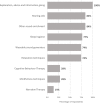An evaluation of paediatric tinnitus services in UK National Health Service audiology departments
- PMID: 32171314
- PMCID: PMC7071756
- DOI: 10.1186/s12913-020-5040-y
An evaluation of paediatric tinnitus services in UK National Health Service audiology departments
Abstract
Background: Whilst evidence indicates many children experience troublesome tinnitus, specialist services for children are far less established than those available for adults. To date, there is limited understanding of how paediatric tinnitus is managed in the UK, and to what extent current practice reflects what is recommended. This service evaluation aimed to 1) profile how tinnitus in children is managed in UK clinical practice, and assess to what extent care provided by services reflects advice included in the British Society of Audiology (BSA) Tinnitus in Children Practice Guidance, 2) collate clinician opinions on how services may be optimised, and 3) identify common problems experienced by children who present with bothersome tinnitus in clinic.
Methods: As part of a larger survey, eight questions regarding services for paediatric tinnitus were distributed to UK NHS audiology services via email and social media. Representatives from eighty-seven services responded between July and September 2017.
Results: Fifty-three percent of respondents reported that their department provided a paediatric tinnitus service. Among these services, there was widespread use of most BSA recommended assessments and treatments. Less widely used practices were the assessment of mental health (42%), and the use of psychological treatment approaches; cognitive behavioural therapy (CBT) (28%), mindfulness (28%), and narrative therapy (14%). There was varied use of measurement tools to assess tinnitus in children, and a minority of respondents reported using adult tinnitus questionnaires with children. Frequently reported tinnitus-related problems presented by children were sleep difficulties, concentration difficulties at school, situation-specific concentration difficulties, and emotional distress.
Conclusions: Approaches used to manage children with troublesome tinnitus in UK NHS services are largely consistent and reflective of the current practice guidance. However, findings from this study indicate specialist staff training, access to child-specific tools, and the treatment and referral of children with tinnitus-related psychological problems represent key areas in need of optimisation.
Keywords: Audiology; Care provision; Child; Clinical management; Healthcare quality; Service evaluation; Tinnitus.
Conflict of interest statement
DJH is currently acting as an Associate Editor for BMC Health Services Research.
Figures
Similar articles
-
Tinnitus referral pathways within the National Health Service in England: a survey of their perceived effectiveness among audiology staff.BMC Health Serv Res. 2011 Jul 6;11:162. doi: 10.1186/1472-6963-11-162. BMC Health Serv Res. 2011. PMID: 21733188 Free PMC article.
-
Promotion and views on tinnitus self-help within United Kingdom national health service audiology departments.Int J Audiol. 2018 Dec;57(12):900-907. doi: 10.1080/14992027.2018.1512013. Epub 2018 Sep 27. Int J Audiol. 2018. PMID: 30261766
-
Tinnitus and hyperacusis therapy in a UK National Health Service audiology department: Patients' evaluations of the effectiveness of treatments.Int J Audiol. 2016 Sep;55(9):514-22. doi: 10.1080/14992027.2016.1178400. Epub 2016 May 19. Int J Audiol. 2016. PMID: 27195947 Free PMC article.
-
A scoping review to catalogue tinnitus problems in children.Int J Pediatr Otorhinolaryngol. 2019 Jul;122:141-151. doi: 10.1016/j.ijporl.2019.04.006. Epub 2019 Apr 11. Int J Pediatr Otorhinolaryngol. 2019. PMID: 31029948
-
Tinnitus in children: an uncommon symptom?Arch Dis Child. 2010 Aug;95(8):645-8. doi: 10.1136/adc.2009.168252. Epub 2010 Apr 6. Arch Dis Child. 2010. PMID: 20371585 Review.
Cited by
-
Tinnitus in Children.J Assoc Res Otolaryngol. 2024 Jun;25(3):239-247. doi: 10.1007/s10162-024-00944-3. Epub 2024 May 6. J Assoc Res Otolaryngol. 2024. PMID: 38709437 Free PMC article. Review.
-
Reducing the Impact of Tinnitus on Children and Adolescents' Lives: A Mixed-Methods Concept Mapping Study.Int J Pediatr. 2021 May 31;2021:5534192. doi: 10.1155/2021/5534192. eCollection 2021. Int J Pediatr. 2021. PMID: 34158816 Free PMC article.
-
Auditory complications among childhood cancer survivors and health-related quality of life: a PanCareLIFE study.J Cancer Surviv. 2025 Feb;19(1):162-173. doi: 10.1007/s11764-023-01456-4. Epub 2023 Sep 22. J Cancer Surviv. 2025. PMID: 37736773 Free PMC article.
References
-
- Tyler R, Baker LJ. Difficulties experienced by tinnitus sufferers. J Speech Hear Disord. 1983;48:150–154. - PubMed
-
- Department of Health. Provision of Services for Adults with Tinnitus: A Good Practice Guide. Department of Health January; 2009. https://webarchive.nationalarchives.gov.uk/20130124045237/http://www.dh..... Accessed 19 Jul 2018.
-
- Davis AC. The prevalence of hearing impairment and reported hearing disability among adults in Great Britain. Int J Epidemiol. 1989;18(4):911–917. - PubMed
-
- Humphriss R, Hall A, Baguley D. Prevalence and characteristics of spontaneous tinnitus in 11-year-old children. Int J Audiol. 2016;55(3):142–148. - PubMed
MeSH terms
Grants and funding
LinkOut - more resources
Full Text Sources
Medical
Research Materials



